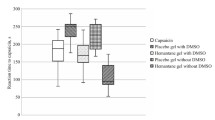Summary
The effects of topical capsaicin (a liberator of substance P) and topical anesthesia were studied in order to obtain information about the role of sensory nerves and substance P in the pathophysiology of nonimmunologic immediate contact reactions (NIICRs) induced by benzoic acid (BA) and methyl nicotinate (MN) in human skin. BA 500, 250, 125, 62, and 31 mM and MN 50, 25, 13, 7, 3, 1.5, and 0.75 mM in petrolatum were tested on the skin areas pretreated with capsaicin solution in 13 test subjects. BA 500, 125, 62, and 31 mM and MN 25, 10, 2, and 0.5 mM in petrolatum were tested on skin areas of 15 test subjects, anesthesized with a topical anesthetic cream (lidocaine 25 mg/g, prilocaine 25 mg/g). Prick tests with histamine dihydrochloride (10 mg/ml) were also performed on test and reference areas. Reactions were monitored 40 min after application with laser-Doppler flowmetry, and the sizes of erythema and edema reactions were measured. Capsaicin treatment inhibited erythema reactions to histamine, but did not inhibit erythema or edema from BA and MN. Topical anesthesia inhibited erythema and edema reactions to histamine as well as to BA and MN. These results suggest that neither erythema nor edema reactions to BA and MN are mediated by mechanisms sensitive to capsaicin (substance P). The mechanism by which a topical anesthetic inhibits skin reactions may result from its effect on cutaneous nerves, or it may have general antiinflammatory properties.
Access this chapter
Tax calculation will be finalised at checkout
Purchases are for personal use only
Preview
Unable to display preview. Download preview PDF.
Similar content being viewed by others
References
Bernstein JE, Swift RM, Keyoumars S, Lorincz AL (1981) Inhibition of axon reflex vasodilatation by topically applied capsaicin. J Invest Dermatol 76: 394–395.
Carpenter SE, Lynn B (1981) Vascular and sensory responses of human skin to mild injury after topical treatment of capsaicin. Br J Pharmacol 73: 755–758.
Danielson K, Evers H (1987) Dermal analgesia after epicutaneous application of lidocaine/prilocaine cream. In: 17th world congress of dermatology, Berlin.
Fitzgerald M (1983) Capsaicin and sensory neurones — a review. Pain 15: 109–130.
Foreman JC (1986) Neuropeptides and the pathogenesis of allergy. Allergy 42: 1–11.
Gollhausen R, Kligman AM (1985) Human assay for identifying substances which induce non-allergic contact urticaria: the NICU-test. Contact Dermatitis 13: 98–106.
Hägermark Ö, Hökfelt T, Pernow B (1978) Flare and itch induced by substance P in human skin. J Invest Dermatol 71: 233–235.
Jancso N (1960) Role of the nerve terminals in the mechanism of inflammatory reactions. Bull Buffalo 7: 53–77.
Johnson HG, Miller MD (1979) Inhibition of histamine release and ionophore-induced calcium flux in rat mast cells by lidocaine and chlorpromazine. Agents Actions 9: 239–243.
Kazimierczak W, Peret M, Maslinski C (1976) The action of local anesthetics on histamine release. Biochem Pharmacol 25: 1747–1750.
Lahti A (1980) Non-immunologic contact urticaria. Acta Derm Venereol [Suppl 91] (Stockh) 60: 1–49.
Lahti A, McDonald DM, Tammi R, Maibach HI (1986) Pharmacological studies on non-immunologic contact urticaria in guinea pigs. Arch Dermatol Res 279: 44–49.
Lahti A, Oikarinen A, Viinikka L, Ylikorkala O, Hannuksela M (1983) Prostaglandins in contact urticaria induced by benzoic acid. Acta Derm Venereol (Stockh) 63: 425–427.
Lundberg JM, Saria A, Rosell S, Folkers K (1984) A substance P antagonist inhibits heat-induced oedema in the rat skin. Acta Physiol Scand 120: 145–146.
Author information
Authors and Affiliations
Editor information
Editors and Affiliations
Rights and permissions
Copyright information
© 1989 Springer-Verlag Berlin Heidelberg
About this paper
Cite this paper
Larmi, E., Lahti, A., Hannuksela, M. (1989). Effects of Capsaicin and Topical Anesthesia on Nonimmunologic Immediate Contact Reactions to Benzoic Acid and Methyl Nicotinate. In: Frosch, P., Dooms-Goossens, A., Lachapelle, JM., Rycroft, R.J.G., Scheper, R.J. (eds) Current Topics in Contact Dermatitis. Springer, Berlin, Heidelberg. https://doi.org/10.1007/978-3-642-74299-6_89
Download citation
DOI: https://doi.org/10.1007/978-3-642-74299-6_89
Publisher Name: Springer, Berlin, Heidelberg
Print ISBN: 978-3-642-74301-6
Online ISBN: 978-3-642-74299-6
eBook Packages: Springer Book Archive




